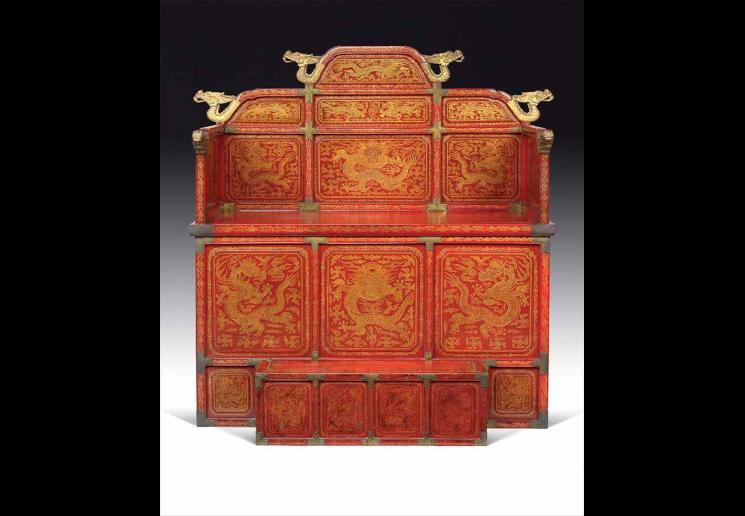THIS EXHIBITION OF Korean Art during the Joseon dynasty is the first major US exhibition to explore the colourfully choreographed ceremonies of Korea’s Joseon dynasty (1392-1910). The legacy of this dynasty, amongst the world’s longest, continues to resonate in Korean culture today.
On show are important objects (several officially designated as Korean Treasures by the country’s Cultural Heritage Administration) that bring to life the grand festivals when milestones like birthdays and weddings were celebrated with elaborate rites that sometimes involved thousands of participants and continued for days. Dance, music, and procession all had parts in the joyous festivities, while exacting rules were prescribed that governed even the placement of dishes at a banquet table.
The story is explored through such treasured objects as a king’s seal and jade book, royal placenta jars, and a large screen painting that celebrates the birth of a crown prince. The Joseon era began in 1392 with Yi Seonggye (reigned 1392–1398), a general victorious over invaders of Korea. Yi led the country after the fall of Korea’s Goryeo dynasty and was enthroned as King Taejo, whose royal family went on to rule for more than 500 years, one of the world’s longest dynasties.
So important are these rituals and celebrations that they have been recorded throughout centuries in comprehensive detail in writings and paintings that form multi-volume books known as royal protocols (uigwe). The uigwe commemorative documentation is so detailed that it is possible even today to reconstruct the ancient ceremonies. These remarkable books serve as vivid and reliable documentation of life in Korea.
The 1795 ceremonial journey of the king to his father’s tomb was so meaningful with its spectacular display and demonstration of filial piety (the Confucian virtue of respect for parents) that it is re-enacted by thousands of people annually in Korea today. The journey has historical significance because King Jeongjo made great efforts to rehabilitate the status of his father, Crown Prince Sado, who had been killed before he could take the crown. The son named his late father King Jangjo.
Many aspects of Korean art during the Joseon period reflect spiritual themes: bringing good fortune, repelling evil spirits, and conveying hopes for a long life.These themes are found in the symbolism of objects like paintings and clothing, and in the traditions observed on major Korean holidays such as Lunar New Year and Thanksgiving. Thousands of people participated in the festive events depicted in Welcoming Ceremonies for the Governor of Pyeong-an, involving night boating on Daedong River and celebrations at Yeon-gwang and Bubyeok pavilions.
Elaborate bridal robes were originally part of a princess’s ceremonial attire, but commoners were allowed to wear them too, although only for wedding ceremonies. Patterns are often embroidered on these robes, including the Ten Symbols of Longevity (turtle, deer, crane, pine tree, bamboo, clouds, mountains, water, sun and mushroom of immortality).
The careful, detailed organisation of extensive events marking political appointments, birthdays, weddings, funerals, and other occasions in Joseon society sprang from the Confucian principle that ritual and order are the foundations of a stable, peaceful civilisation. Through 115 artworks, In Grand Style explores what it meant to be a king during the Joseon dynasty; royal processions and banquets; the power of women at court; and the lives and celebrations of the Joseon people.
Highlights include an ornate palanquin – measuring more than 8 feet long – used for carrying a king or queen; a book of praise for King Taejo, made entirely of jade and inscribed with gold; a 150-feet-long handscroll depicting King Jeongjo’s famous procession to his father’s tomb; a royal throne; as well as kings’ and queens’ seals and protocol books with paintings of royal banquets, ceremonial robes and furniture.
This is the 10th anniversary of the museum at its Civic Center location. ‘In 2003 the museum opened with a show about Korea’s Goryeo dynasty. Ten years later, through this exhibition focusing on the succeeding Joseon dynasty, we celebrate our first decade at the Civic Center, we celebrate the marvellous arts of Korea, and ultimately we celebrate the art of celebration itself,’ commented Jay Xu, Director of the Asian Art Museum.
In Grand Style: Celebrations in Korean Art During the Joseon Dynasty runs 25 October 2013 to 12 January 2014 at the The Asian Art Museum, 200 Larkin Street, San Francisco, www.asianart.org. The museum is the only venue for the exhibition. Catalogue available.

